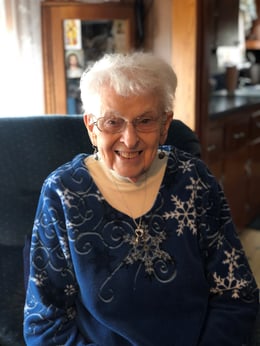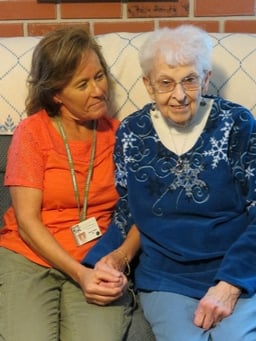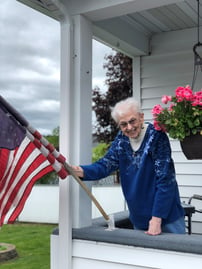Anne Carle, RN, Telehealth Clinical Coordinator at Cornerstone VNA, shared with HRS a wonderful patient success story. In her own words, read her story below about customizing a patient's care plan through the use of telehealth.

Managing CHF Before Telehealth
At 93 years old, Marie has Congestive Heart Failure (CHF) and was recently hospitalized for difficulty breathing. Marie also has end-stage renal disease (ESRD) and degenerative eyesight. After more than a week in the hospital, Marie was discharged back home with her daughter, who is her primary caregiver. Due to her chronic conditions and need for care at home to improve her health, Marie was referred to Cornerstone VNA.
Skilled nursing was ordered to provide education and teaching to Marie regarding her conditions and to provide medication management. Upon admission and initial assessment, her home care nurse initiated a Palliative Care referral as well so that a certified Palliative Care Nurse could provide her with better symptom management to improve her quality of life.
Although Marie lives with her daughter, she is often alone for a few hours each day while her daughter is at work. Understandably, Marie was feeling fearful and concerned that she was not going to be able to manage her chronic symptoms. Given the situation and the severity of her chronic conditions, Marie’s case manager, Amy Dubois, RN, discussed the benefits of using a telehealth monitoring system in the home. She explained that telehealth would be used to monitor her very closely and would help ease her anxiety, especially during the times when she would be home alone and would help keep her out of the hospital.
Understanding Telehealth
In 2016, Cornerstone VNA partnered with Health Recovery Solutions (HRS) to provide more advanced care and monitoring, through the use of telehealth, to chronic care patients such as those diagnosed with CHF, chronic obstructive pulmonary disease (COPD), and hypertension. The Telehealth monitoring system uses a 4G Samsung tablet with wireless devices, including a blood pressure monitor, pulse oximeter to measure heart rate and O2 saturation, and a scale. When patients use these devices to check their vital signs, their information is stored on the telehealth unit and shared with the Telehealth Clinical Coordinator at Cornerstone VNA. In addition to providing video conferencing, each tablet is customized to a patient’s specific disease, which includes educational videos, educational booklets, survey questions, and reminders.
Amy explained to Marie that her numeric readings would transmit back to Cornerstone VNA via a web portal and would be closely monitored daily by the Telehealth Clinical Coordinator, Anne Carle, RN. If Anne identified any abnormalities, Marie would receive a call to triage her symptoms, and a video call would be initiated to make a visual assessment. Amy further explained that the Telehealth Nurse would provide a report to Marie’s physician so that he could treat her symptoms as needed.

Finding a New Solution
Although Marie was somewhat receptive to Telehealth, she was reluctant about having extra equipment in her home and wanted to be able to use her own equipment. To address Marie’s concerns, Amy initiated a telephone call with the Telehealth Nurse, Anne, in an effort to think of an innovative way to accommodate Marie’s wishes. Anne explained that Marie could use the “Patient Connect Mobile App” created by Health Recovery Solutions that could be downloaded easily to her smartphone. The mobile app includes all of the same features as the Telehealth tablet, and she would be able to utilize her own equipment. The only difference was that Marie would have to manually input her daily readings into the app for Anne to review them.
Marie was willing to do so; however she stated, “my eyesight is very poor, and seeing words or numbers on a smartphone is very difficult for me.” Marie added, “My daughter got me accustomed to using an iPad because the images and words are bigger and clearer for me to see.” Right away, Anne contacted HRS to explain the situation and asked if the “Patient Connect Mobile App” software could be downloaded to Marie’s iPad instead of her smartphone. The situation was discussed with Nolan Santosa, Director of Client Success, and Angelo Popper, Director of Product & Support. Both agreed upon the option, knowing it was in the best interest of the patient.
Connecting the software to Marie’s iPad was a success, and a video call was initiated so that Marie and Anne could meet one another. With the assistance of her daughter, Marie faithfully began taking her vital signs and entering them into the app to be monitored daily by Anne.
Life After Telehealth
One week later, while reviewing Marie’s readings, Anne noticed that her weight increased by 7lbs in 24hrs. Anne explained, “I immediately did a video call to Marie, but she did not answer. Instead, I was able to reach Marie by phone to triage her symptoms. Marie sounded in good spirits on the phone. She was talking in clear sentences and was not short of breath, but she told me that she had some lower extremity edema to her left leg.” Marie explained that she always has edema to that leg due to several surgeries, but the edema was worse that day. Since Marie was not feeling short of breath, she didn’t feel as though a nursing visit was necessary, but Anne called Marie’s primary care physician right away. Anne spoke with the physician’s Medical Assistant and reported Marie’s weight gain and symptoms. Her physician increased Marie’s furosemide, a diuretic, to help reduce the extra fluid in her body.
 After a few days, Marie’s weight stabilized and the edema to the left leg diminished. Marie did not have to be treated in the emergency room or readmitted back to the hospital to treat her CHF symptoms. The collaboration between Anne and Marie’s primary care physician prevented her condition from worsening and led to a positive outcome for Marie. The Medical Assistant from Marie’s doctor’s office stated, “The primary care physician is thrilled with the service Cornerstone VNA is providing for his patient and with the use of Telehealth provided by HRS.” She added, “He is grateful for the extra eyes on his patient.”
After a few days, Marie’s weight stabilized and the edema to the left leg diminished. Marie did not have to be treated in the emergency room or readmitted back to the hospital to treat her CHF symptoms. The collaboration between Anne and Marie’s primary care physician prevented her condition from worsening and led to a positive outcome for Marie. The Medical Assistant from Marie’s doctor’s office stated, “The primary care physician is thrilled with the service Cornerstone VNA is providing for his patient and with the use of Telehealth provided by HRS.” She added, “He is grateful for the extra eyes on his patient.”
Marie stated, “I have been fearful of going back to the hospital due to my chronic condition. My brother has Congestive Heart Failure and has been back to the hospital more than once. I am so grateful that a nurse is always watching over me.” According to Palliative Care Nurse, Mitch Maihiot, RN, CHPN, “Marie shared with me that she wants to live to be 100 years old!”
Thanks to the collaboration between Cornerstone VNA clinicians, experts from HRS, and Marie’s primary care team, Cornerstone VNA was able to accommodate Marie’s needs and address her symptoms in a timely manner, which has allowed her to remain in the comfort of her home with her daughter
Written by Anne Carle, RN, Telehealth Clinical Manager at Cornerstone VNA
